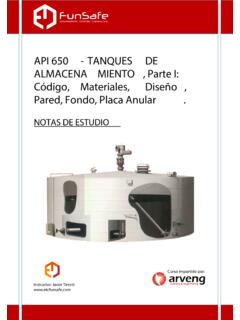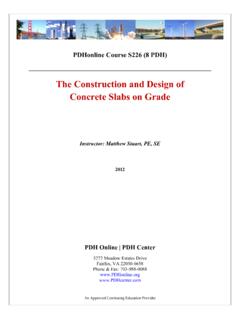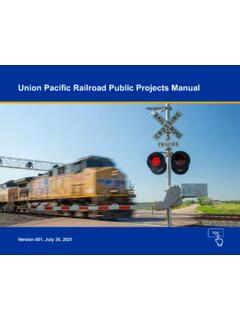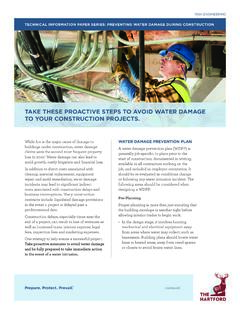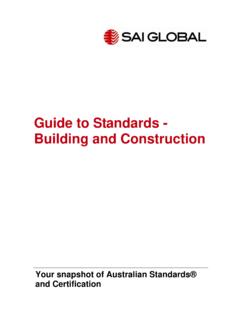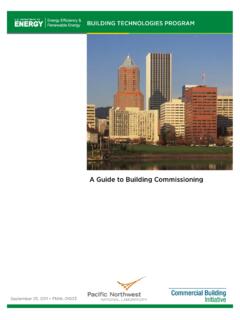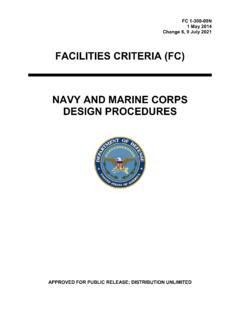Transcription of API 650 – ABOVEGROUND STORAGE TANKS, Part I: Code ...
1 API 650 aboveground storage tanks , part I: Code, Materials, design , Wall, Bottom, Annular Plate. STUDY NOTES Instructor: Javier Tirenti Training Projects Connecting Dots ABOVEGROUND STORAGE tanks , part I Instructor Javier Tirenti P g. 2 Index Introduction .. 4 1. ABOVEGROUND STORAGE tanks .. 5 ) design codes .. 6 2. API 650 code .. 9 ) Scope .. 10 ) Code organization .. 11 ) Other applicable codes .. 13 ) Reference books .. 14 3. Material selection .. 15 ) Corrosion .. 16 ) Corrosion types .. 17 ) Corrosion allowance.
2 20 ) Essential properties of materials .. 22 ) Material designation .. 27 ) Materials most frequently used .. 29 ) General requirements .. 31 4. design conditions .. 33 ) STORAGE capacity .. 34 ) design loads .. 35 ) Internal pressure .. 36 ) External pressure .. 40 ) design temperature .. 41 5. Tank shell design .. 43 ) Thickness calculation by the 1-foot Method .. 44 ) Minimum thickness .. 45 6. Tank bottom design .. 46 ) Annular ring .. 49 7. Nozzle design .. 51 ) Nozzle configuration .. 52 ) Standard flanges .. 53 ) Nozzle necks .. 55 ) Gaskets .. 56 ) Reinforcements.
3 57 ) Sound practices .. 58 Training Projects Connecting Dots ABOVEGROUND STORAGE tanks , part I Instructor Javier Tirenti P g. 3 ) Nozzles in tanks .. 59 8. Bibliography sources .. 68 Training Projects Connecting Dots ABOVEGROUND STORAGE tanks , part I Instructor Javier Tirenti P g. 4 Introduction Continuous production processes (such as refineries) require the STORAGE of products for a later use, transportation or disposal. In such cases, STORAGE is performed according to the physical state of the product: Pressure vessels are used to store gases and liquids at high pressure.
4 Silos are used to store solids, grains, etc. STORAGE tanks are used to store liquids with low pressure. Such tanks are widely used in different industries for temporary STORAGE of products to be used later. STORAGE is an element of great value in different industries because: Represents a buffer between production of products and transportation, mainly to absorb variations in consumption. Allows water and mud sedimentation of the stored product prior to shipping (through a pipeline or distillation). Provides operational flexibility to the production process.
5 Acts as a benchmark, especially in Regulating and Measuring Stations (RMS). tanks are part of various industrial operations such as: Production Treatment Refining Transport / Distribution Inventory Training Projects Connecting Dots ABOVEGROUND STORAGE tanks , part I Instructor Javier Tirenti P g. 5 1. ABOVEGROUND STORAGE tanks From all types of containers STORAGE tanks are the most used. The different types of tanks are used to store a variety of products such as crude oil and its derivatives, butane, propane, LPG, solvents, water, etc.
6 STORAGE tanks are used as reservoirs to contain a sufficient reserve of any product for later use and or commercialization. Vertical cylindrical flat bottom tanks allow us to store large volumetric quantities at low cost, with the only limitation that they can only be used at atmospheric pressure or relatively small internal pressures. Training Projects Connecting Dots ABOVEGROUND STORAGE tanks , part I Instructor Javier Tirenti P g. 6 ) design codes There are different design codes applicable to STORAGE tanks .
7 Before any design , the end user must establish the appropriate design code for the tank operation. design codes most commonly used for STORAGE tanks will be described in the sections below. ) API 650 tanks in which liquid fluids are stored and designed to withstand atmospheric pressure operation, less than 18 kPa, or internal pressures not exceeding the weight of the roof, with temperatures no higher than 93, 3 C are included in the scope of this design code. Internal temperatures could go up to 260 C with certain restrictions (Annex M).
8 Training Projects Connecting Dots ABOVEGROUND STORAGE tanks , part I Instructor Javier Tirenti P g. 7 The standard API 650 covers the design and calculation of the different elements of the tank. In view of the materials of construction , requirements and recommendations are set forth, : erection sequences, welding procedures, tests and inspections as well as guidelines for operation. ) API 620 The standard API 620 covers the design and construction of large tanks fabricated with carbon steel, working at medium pressure level, vertical, ABOVEGROUND and with operating temperatures no higher than 93,3 C.
9 The range of pressure within the scope of this is: 18 kPa <Internal Pressure 103,4 kPa Also, Annex "R" applies to tanks operating between 4,44 C and -51,1 C. Annex "Q" applies to STORAGE tanks for liquefied gases (cryogenic service) with temperatures down to -167,8 C. ) ASME ANSI The requirements of this standard are similar to the ones presented in API 650 Code, but applicable to STORAGE tanks made of aluminum. ) AWWA 1000 American Water Works Association , Standard for Welded Steel Elevated tanks , Stand Pipes and Reservoirs for Water STORAGE . This directive does not establish specific equations or design methods to determine the design of the various components; on the contrary, it establishes general requirements associated with design loads, allowable stresses, radiographic examinations, etc.
10 This directive should be used jointly with a design code. The directive states that API 650 code design methods may be used. ) API 12D This standard covers the design , manufacture and installation of vertical ABOVEGROUND cylindrical tanks , steel fabricated and welded, with nominal capacities ranging from m3 to 1590 m3 (in standard sizes). ) API 12F The requirements of this standard are similar to API 12D, in this case for tanks that will be manufactured at workshops, with nominal capacities ranging from to m3. ) Comparison Considering the diversity of applications that are handled nowadays and whereas is it sometimes difficult to establish the scope of each of the codes Training Projects Connecting Dots ABOVEGROUND STORAGE tanks , part I Instructor Javier Tirenti P g.

